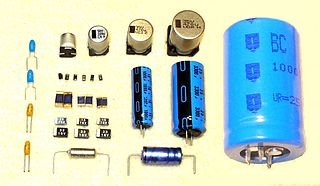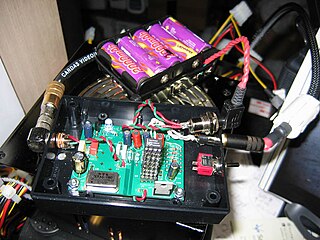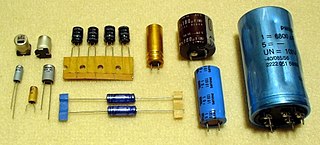Related Research Articles
Mean time between failures (MTBF) is the predicted elapsed time between inherent failures of a mechanical or electronic system, during normal system operation. MTBF can be calculated as the arithmetic mean (average) time between failures of a system. The term is used for repairable systems, while mean time to failure (MTTF) denotes the expected time to failure for a non-repairable system.

A system on a chip is an integrated circuit that integrates all or most components of a computer or other electronic system. These components almost always include a central processing unit (CPU), memory, input/output ports and secondary storage, often alongside other components such as radio modems and a graphics processing unit (GPU) – all on a single substrate or microchip. It may contain digital, analog, mixed-signal, and often radio frequency signal processing functions.

An electrolytic capacitor is a polarized capacitor whose anode or positive plate is made of a metal that forms an insulating oxide layer through anodization. This oxide layer acts as the dielectric of the capacitor. A solid, liquid, or gel electrolyte covers the surface of this oxide layer, serving as the cathode or negative plate of the capacitor. Due to their very thin dielectric oxide layer and enlarged anode surface, electrolytic capacitors have a much higher capacitance-voltage (CV) product per unit volume than ceramic capacitors or film capacitors, and so can have large capacitance values. There are three families of electrolytic capacitor: aluminum electrolytic capacitors, tantalum electrolytic capacitors, and niobium electrolytic capacitors.
Mean time to recovery (MTTR) is the average time that a device will take to recover from any failure. Examples of such devices range from self-resetting fuses, up to whole systems which have to be repaired or replaced.
Failure rate is the frequency with which an engineered system or component fails, expressed in failures per unit of time. It is usually denoted by the Greek letter λ (lambda) and is often used in reliability engineering.

DIY Audio means "do it yourself" audio. Rather than buying a piece of possibly expensive audio equipment, such as a high-end audio amplifier or speaker, the person practicing DIY Audio will make it him/herself. Alternatively, a DIYer may take an existing manufactured item of vintage era and update or modify it. The benefits of doing so include the satisfaction of creating something enjoyable, the possibility that the equipment made or updated is of higher quality than commercially available products and the pleasure of creating a custom-made device for which no exact equivalent is marketed. Other motivations for DIY audio can include getting audio components at a lower cost, the entertainment of using the item, and being able to ensure quality of workmanship.
Reliability engineering is a sub-discipline of systems engineering that emphasizes the ability of equipment to function without failure. Reliability describes the ability of a system or component to function under stated conditions for a specified period of time. Reliability is closely related to availability, which is typically described as the ability of a component or system to function at a specified moment or interval of time.
When describing a periodic function in the time domain, the DC bias, DC component, DC offset, or DC coefficient is the mean amplitude of the waveform. If the mean amplitude is zero, there is no DC bias. A waveform with no DC bias is known as a DC balanced or DC free waveform.
Fault tolerance is the property that enables a system to continue operating properly in the event of the failure of some of its components. If its operating quality decreases at all, the decrease is proportional to the severity of the failure, as compared to a naively designed system, in which even a small failure can cause total breakdown. Fault tolerance is particularly sought after in high-availability or life-critical systems. The ability of maintaining functionality when portions of a system break down is referred to as graceful degradation.
Reliability, availability and serviceability (RAS), also known as reliability, availability, and maintainability (RAM), is a computer hardware engineering term involving reliability engineering, high availability, and serviceability design. The phrase was originally used by International Business Machines (IBM) as a term to describe the robustness of their mainframe computers.
Conformal coating material is a thin polymeric film which conforms to the contours of a printed circuit board to protect the board's components. Typically applied at 25-250 μm(micrometers) thickness, it is applied to electronic circuitry to protect against moisture, dust, chemicals, and temperature extremes.
In computing, an eFuse is a microscopic fuse put into a computer chip. This technology was invented by IBM to allow for the dynamic real-time reprogramming of chips. In the abstract, computer logic is generally "etched" or "hard-wired" onto a chip and cannot be changed after the chip has finished being manufactured. By utilizing a set of eFuses, a chip manufacturer can allow for the circuits on a chip to change while it is in operation.
PCell stands for parameterized cell, a concept used widely in the automated design of analog integrated circuits. A PCell represents a part or a component of the circuit whose structure is dependent on one or more parameters. Hence, it is a cell which is automatically generated by electronic design automation (EDA) software based on the values of these parameters. For example, one can create a transistor PCell and then use different instances of the same with different user defined lengths and widths. Vendors of EDA software sometimes use different names for the concept of parameterized cells, e.g. T-Cell and Magic Cell.

Metal electrode leadless face (MELF) is a type of leadless cylindrical electronic surface mount device that is metallized at its ends. MELF devices are usually diodes and resistors.

A tantalum electrolytic capacitor is an electrolytic capacitor, a passive component of electronic circuits. It consists of a pellet of porous tantalum metal as an anode, covered by an insulating oxide layer that forms the dielectric, surrounded by liquid or solid electrolyte as a cathode. Because of its very thin and relatively high permittivity dielectric layer, the tantalum capacitor distinguishes itself from other conventional and electrolytic capacitors in having high capacitance per volume and lower weight.
Accelerated life testing is the process of testing a product by subjecting it to conditions in excess of its normal service parameters in an effort to uncover faults and potential modes of failure in a short amount of time. By analyzing the product's response to such tests, engineers can make predictions about the service life and maintenance intervals of a product.

A polymer capacitor, or more accurately a polymer electrolytic capacitor, is an electrolytic capacitor (e-cap) with a solid conductive polymer electrolyte. There are four different types:
Integrated vehicle health management (IVHM) or integrated system health management (ISHM) is the unified capability of systems to assess the current or future state of the member system health and integrate that picture of system health within a framework of available resources and operational demand.
The integrated circuit (IC) chip was invented during 1958–1959. The idea of integrating electronic circuits into a single device was born when the German physicist and engineer Werner Jacobi developed and patented the first known integrated transistor amplifier in 1949 and the British radio engineer Geoffrey Dummer proposed to integrate a variety of standard electronic components in a monolithic semiconductor crystal in 1952. A year later, Harwick Johnson filed a patent for a prototype IC. Between 1953 and 1957, Sidney Darlington and Yasuo Tarui proposed similar chip designs where several transistors could share a common active area, but there was no electrical isolation to separate them from each other.

Aluminium capacitors are polarized electrolytic capacitors whose anode electrode (+) is made of a pure aluminum foil with an etched surface. The aluminum forms a very thin insulating layer of aluminium oxide by anodization that acts as the dielectric of the capacitor. A non-solid electrolyte covers the rough surface of the oxide layer, serving in principle as the second electrode (cathode) (-) of the capacitor. A second aluminum foil called “cathode foil” contacts the electrolyte and serves as the electrical connection to the negative terminal of the capacitor.
References
- ↑ Bjarne E. Helvik (2007). Dependable Computing Systems and Communication Networks. Gnist Tapir. p. 26.
- ↑ "Weibull General Simulation Results" . Retrieved 2011-07-01.CS1 maint: discouraged parameter (link)
- ↑ "Sigma Six Quality Control Dictionary and Glossary" . Retrieved 2011-07-01.CS1 maint: discouraged parameter (link)